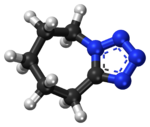 | |
 | |
| Clinical data | |
|---|---|
| Trade names | Metrazol, others |
| Other names | PTZ; Pentylenetetrazole; Leptazol; Metrazol; Pentetrazol; Pentamethylenetetrazol |
| ATC code | |
| Identifiers | |
| |
| CAS Number | |
| PubChem CID | |
| ChemSpider | |
| UNII | |
| KEGG | |
| ChEBI | |
| ChEMBL | |
| CompTox Dashboard (EPA) | |
| ECHA InfoCard | 100.000.200 |
| Chemical and physical data | |
| Formula | C6H10N4 |
| Molar mass | 138.174 g·mol−1 |
| 3D model (JSmol) | |
| |
| |
| | |
Pentylenetetrazol (PTZ), also known as pentylenetetrazole, leptazol, metrazol, pentetrazol (INN), pentamethylenetetrazol, Corazol, Cardiazol, or Deumacard, is a drug formerly used as a circulatory and respiratory stimulant. High doses cause convulsions, as discovered by Hungarian-American neurologist and psychiatrist Ladislas J. Meduna in 1934. It has been used in convulsive therapy, and was found to be effective—primarily for depression—but side effects such as uncontrolled seizures were difficult to avoid.[1] In 1939, pentylenetetrazol was replaced by electroconvulsive therapy, which is easier to administer, as the preferred method for inducing seizures in England's mental hospitals. In the US, its approval by the Food and Drug Administration was revoked in 1982.[2] It is used in Italy as a cardio-respiratory stimulant in combination with codeine in a cough suppressant drug.[3]
- ^ Read CF (1940). "Consequences of metrazol shock therapy". American Journal of Psychiatry. 97 (3): 667–76. doi:10.1176/ajp.97.3.667.
- ^ Minkel JR (February 25, 2007). "Drug May Counteract Down Syndrome". Scientific American. Retrieved 2007-03-20.
- ^ "Cardiazol-Paracodina". Agenzia Italiana del Farmaco.